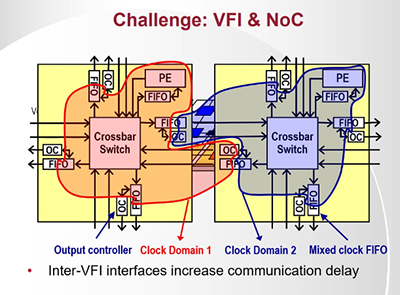Credit: Carnegie Mellon University Electrical and Computer Engineering
In their recent paper, Wireless NoC for VFI-enabled multicore chip design: performance evaluation and design trade-offs, researchers from Carnegie Mellon's Department of Electrical and Computer Engineering and Washington State University identify a new approach for enabling energy-efficient multicore systems. Much like bypassing road congestion when traveling long distances, by using wireless on-chip communication between individually controllable clusters, researchers were able to provide an efficient communication backbone, which can be tailored for large scale multicore systems. This paper presents a platform that is poised to save significant energy with little or no performance penalty. The article is the featured IEEE Transactions on Computers paper for the month of April.
As the number of cores packed into a single chip rises, scalable power management strategies are needed to keep power under prescribed limits. Voltage frequency islands, or VFIs, have long been used to enable such strategies. In VFI-based designs, the system is partitioned into islands with individually adjustable voltage and frequencies so as to reduce the power within allowable performance penalties.
However, while enabling significant power savings, a main challenge of VFI-based designs is the on-chip communication cost which negatively impacts application performance. Indeed, mixed voltage/frequency interfaces must be used for inter-VFI communication, thereby increasing communication delay.
This paper presents two innovative solutions, the first of which is through the VFI clustering methodology. A hybrid VFI clustering that combines both per-VFI utilization and inter-VFI communication enables minimal inter-VFI communication without greatly increasing the inter-cluster utilization variation. Secondly, researchers utilized a small-world wireless Network on Chip or mSWNoC to enable fast and energy efficient on-chip communication. The mSWNoC exploits small-world connectivity for reducing communication costs through wireless long-range short cuts between VFIs.
Credit: Carnegie Mellon University Electrical and Computer Engineering
The wireless small-world connectivity is able to mitigate most of the performance penalties introduced by VFIs. Furthermore, VFI-based multicore systems with mSWNoC communication are shown to be significantly better in energy efficiency compared to classic systems using wired on-chip networks (e.g. mSWNoC improves the energy dissipation by 40% and the energy-delay product by 52% compared to a wireline mesh on common PERSEC and SPLASH-2 benchmarks)
More information: Paper authors include: Ryan Gary Kim, Student Member, IEEE, Wonje Choi, Student Member, IEEE, Guangshuo Liu, Student Member, IEEE, Ehsan Mohandesi, Student Member, IEEE, Partha Pratim Pande, Senior Member, IEEE, Diana Marculescu, Fellow, IEEE, Radu Marculescu, Fellow, IEEE
























